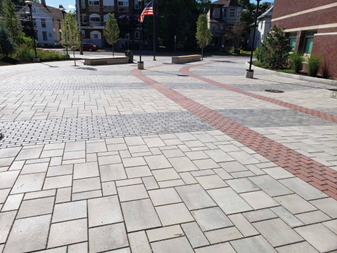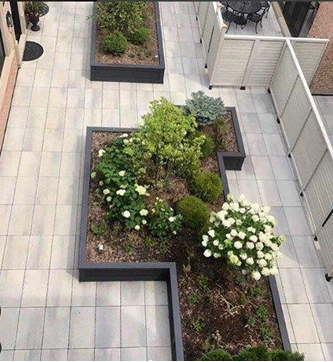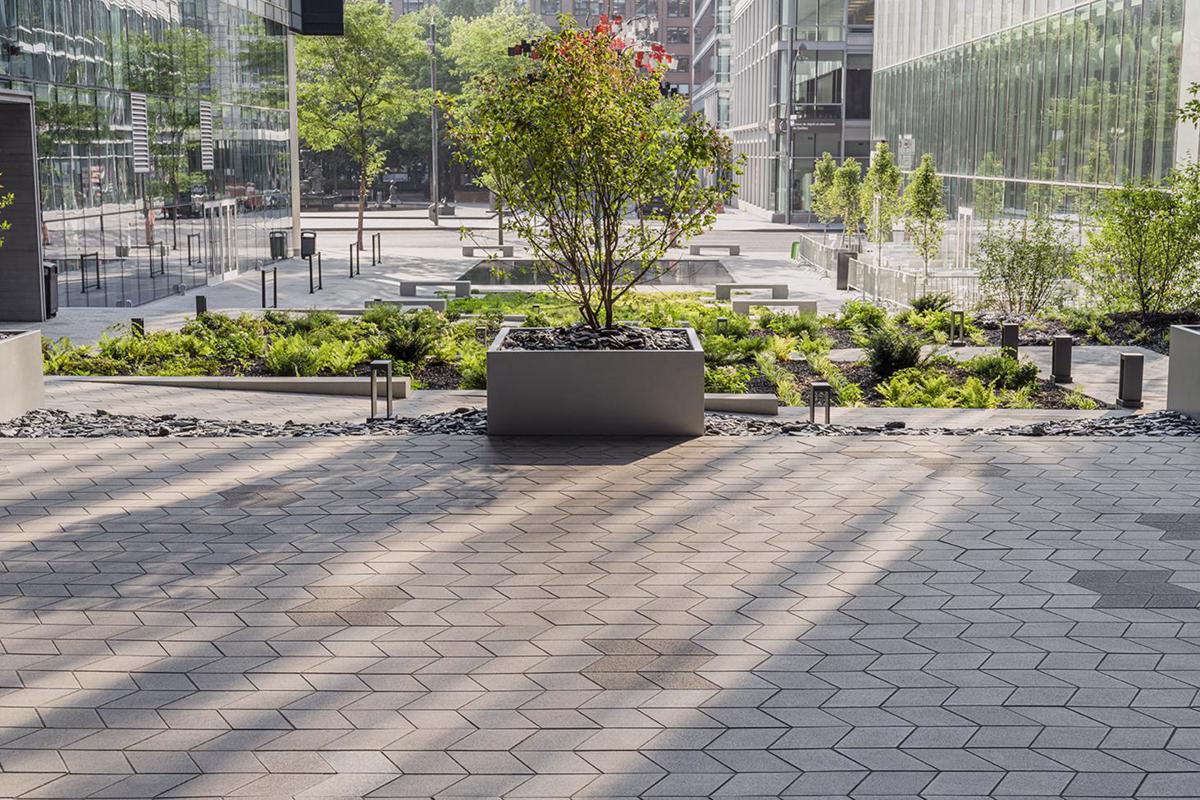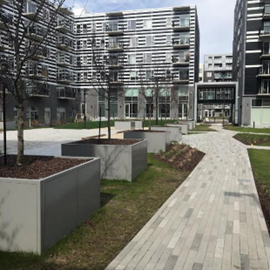It is estimated that the construction sector contributes to 25-40% of the world’s carbon emissions. This pollution not only impacts the air but also the water and the land near building sites, with the waste generated at these sites ending up in landfills, further polluting the environment.
Flooding, erosion, escalating temperatures and pollutants leaking into local streams and rivers are just a few of the negative effects of poorly constructed cities. By carefully designing landscaping and building towards LEED and other sustainability certifications, landscape architects can help lessen the industry’s impact on the environment and offset construction waste and emissions.
Sustainable Planning
Building towards LEED certification begins with sustainable and green planning. You can earn one credit just by creating a written plan for how the exterior landscaping and hardscaping will be maintained.
By carefully considering and documenting the chemicals that will be used to clean or de-ice hardscaping, pest control measures, erosion reduction practices, responsible water usage, and landscaping maintenance, you can help not only achieve LEED certification, but also ensure your client has an exterior maintenance plan for the life of the property.
Coming up with a thoughtful and comprehensive plan from the beginning will guide you — and your client — towards consistently making renewable and sustainable choices for the project.
Recycle Old Materials
Construction material waste is a huge environmental threat, and 90% of this waste comes from demolition. When removing or replacing an existing exterior, think about how the materials can be recycled or reused instead of sent to landfills or incinerated.
Wood, metal and other natural structures can be recycled. Organic material can be composted. Hardware, appliances and fixtures can be carefully taken away and donated to those that need them, recycled or even reused for the project. Concrete and brick can either be recycled or reused as fill.
The more that can be reused and recycled means less waste ending up in landfills which means less environmental pollution. It also means less water and energy used to generate completely new materials.

Regionally Resourced Materials
Whenever possible, source new materials from your project’s local area. This will earn you the Regional Materials LEED credit and will limit the distance vehicles need to haul materials, reducing the unnecessary use of fossil fuels.
Also, think about what eco-friendly or recycled materials you can use that are locally renewable and chemical-free for a healthier project site and community.
Native Plants
When choosing vegetation for projects, consider what plants are native to the area. These plants will thrive in the existing soil, temperature and weather conditions, and will typically need less water and care overall. Native plants will also be naturally resistant to the diseases and pests in the area, as well as a source of food and shelter for local insects and wildlife.
The use of natural plants will also cut down on the need for turf. Turf requires a lot of water, fertilizer and herbicides. It also requires extra maintenance, and replacing turf with local plant material potentially means less mowing, blowing or weed whacking which reduces emissions and the building’s carbon footprint.
Using native plants in place of turf also provides more design options for aesthetically-pleasing, unique and Instagram-worthy landscaping.

Green Roof
Green roofs can be a great way to solve several environmental issues at once and offset unfortunate emissions from construction.
Having vegetation covering rooftops minimizes the amount of heat absorbed into the building itself. Not only does this reduce the overall urban heat island effect, but the extra protective layers act as insulation. This directly translates to a more energy-efficient building and less reliance on HVAC systems to keep the interior cool.
Green roofs are also ideal solutions for stormwater retention and drainage. Instead of stormwater running off the roof of the building, taking pollutants into an already overflowing sewage system and increasing the risk of pollutants and toxins in rivers and streams, the vegetation retains excess stormwater. The more a green roof matures, the more it prevents flooding and erosion.
Green roofs also reduce greenhouse gas emissions, protect and extend the life of the roof, and provide a unique cultural hub for building occupants to enjoy. Consider planting edible fruits, vegetables and herbs that can be used in the building’s restaurant or cafeteria. Providing an open community space and a source of local food production will earn you a credit towards LEEDs certification.
Also, using pedestal-set slabs as the paving surface allows for easier utilities management as necessary drains, pipes, vents and cables can all run easily below the paving units without compromising aesthetics or functionality. Determining the correct materials for these applications isn’t as difficult as it may seem.
Heat Island Reduction
Rising summer temperatures are a serious issue in city management planning. That is why you can earn two LEED credits by taking specific measures to combat the urban heat island effect. This can be achieved by adding in native plants, green roofs and shade trees, but one major overlooked solution lies in strategic hardscaping.
When choosing paving stones, select lighter colored pavers or patio slabs designed to reflect heat and sun rays rather than absorb them. Walkways, plazas and even parking lots can be strategically used to keep city temperatures at more manageable levels.
Stormwater Solutions
An essential part of LEED certification is your plan for stormwater retention and drainage. Overuse of impervious hardscaping materials have led to flooding, overflowing sewage systems, erosion and the increasing amount of toxins and pollutants in local rivers.
Permeable paver systems are an innovative solution that helps prevent flooding and erosion. In permeable paver systems, stormwater flows through the cracks between the pavers. Water then can either seep into the ground underneath or be retained in the base then released slowly into the sewer system. Permeable systems can also have a filtration system in place that reduces the number of pollutants that end up in the water stream. This water retention ability is key in getting those LEED points.
Sustainable Commercial Building
For more information on how your commercial hardscaping can contribute to the entire project’s sustainability and reduce the negative impact that construction has on the environment, download Techo-Bloc’s Complete Guide to LEED Certification and Sustainability on Commercial Sites.
You can also contact us today to speak to a paver expert or visit our product pages for sustainable hardscaping solutions for your next project.



Leave A Comment